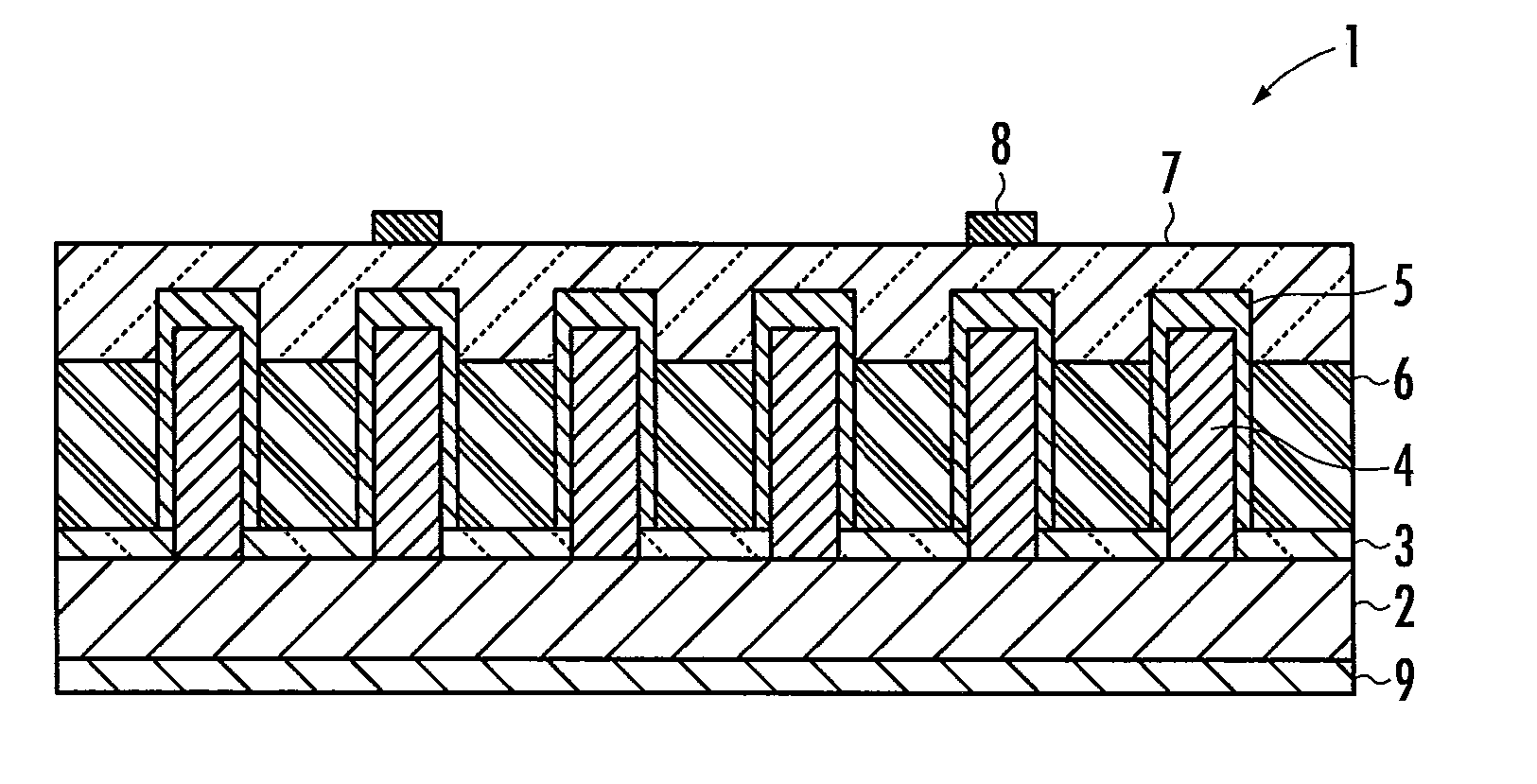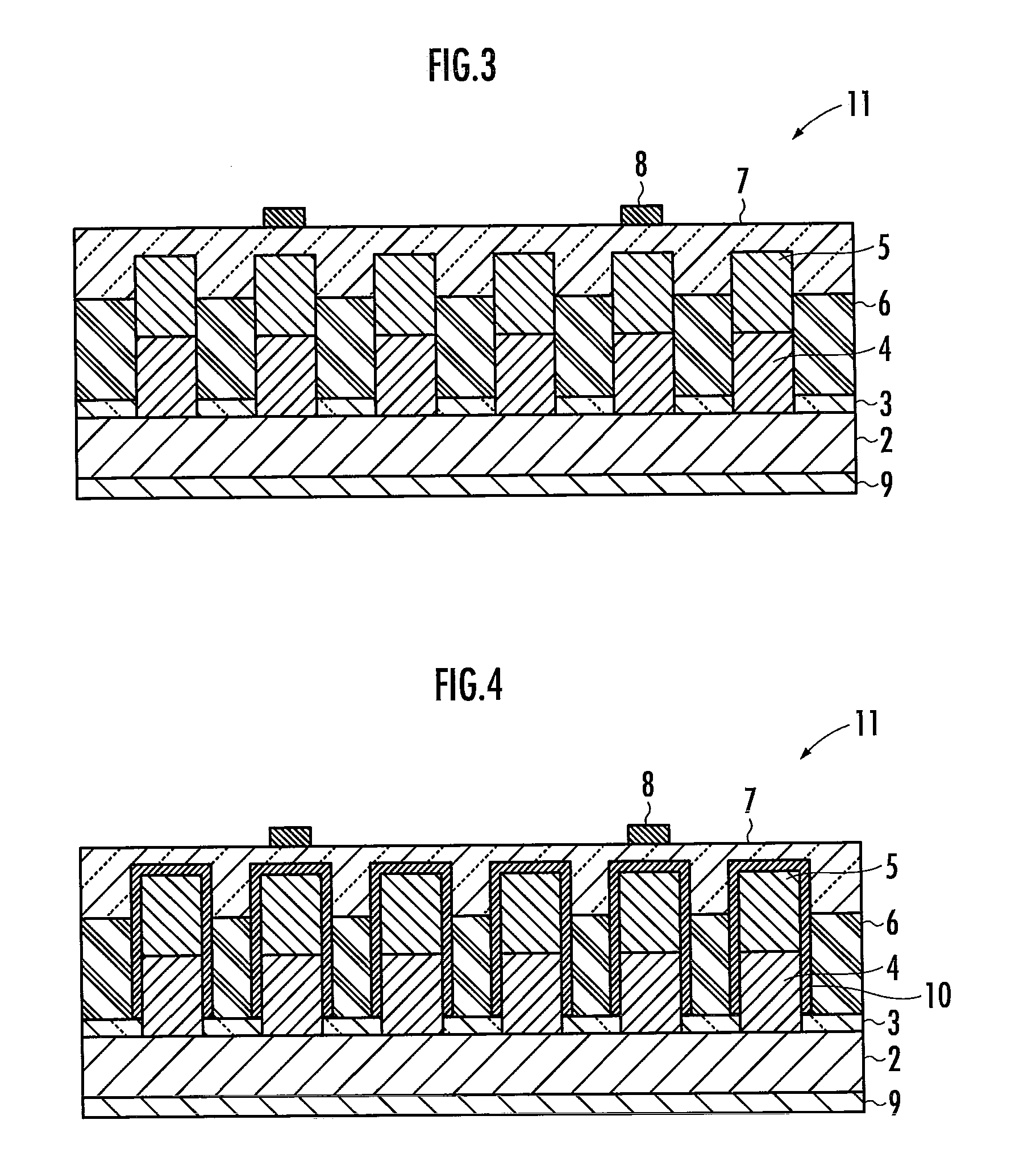Nanowire photovoltaic cells and manufacture method thereof
a photovoltaic cell and nanowire technology, applied in the field of nanowire photovoltaic cells, can solve the problems of nanowire photovoltaic cell photoelectric conversion efficiency degradation, semiconductor layer becoming poly-crystallized, and inability to manufacture devices capable of supplying electric power practically, etc., to achieve the effect of improving the photoelectric conversion efficiency
- Summary
- Abstract
- Description
- Claims
- Application Information
AI Technical Summary
Benefits of technology
Problems solved by technology
Method used
Image
Examples
first embodiment
[0030]First, a nanowire photovoltaic cell 1 according to the present invention will be described with reference to FIG. 1. The nanowire photovoltaic cell 1 is provided with an InP (111) A substrate 2, an amorphous SiO2 film 3 formed on the InP (111) A substrate 2, and a p-type InP nanowire semiconductor 4 formed on a portion of the InP (111) A substrate 2 uncoated by the amorphous SiO2 film 3. The p-type InP nanowire semiconductor 4 has an n-type InP semiconductor 5 formed along the surface thereof. Between the p-type InP semiconductor 4 and the n-type InP semiconductor 5, there is provided an i-type InP semiconductor (not shown). Thereby, the nanowire photovoltaic cell 1 has a core-shell structure with the p-type InP semiconductor 4 served as a core, the i-type InP semiconductor and the n-type InP semiconductor served as a shell.
[0031]The nanowire photovoltaic cell 1 is further provided with a transparent insulator 6 filled between gaps of a plurality of the p-type InP nanowire sem...
second embodiment
[0034]Hereinafter, a nanowire photovoltaic cell 11 according to the present invention will be described with reference to FIG. 3. The nanowire photovoltaic cell 11 has the same structure as the nanowire photovoltaic cell 1 in FIG. 1, except that the n-type InP semiconductor 5 is joined with the p-type InP nanowire semiconductor 4 in the lengthwise direction to form the PN junction. In addition, between the p-type InP semiconductor 4 and the n-type InP semiconductor 5, there is provided an i-type InP semiconductor (not shown).
[0035]As illustrated in FIG. 4, it is also acceptable for the nanowire photovoltaic cell 11 to have the passivation layer 10 disposed on the either surface of the p-type InP nanowire semiconductor 4, the i-type InP semiconductor and the n-type InP semiconductor 5. As illustrated in FIG. 4, it is acceptable to cover totally the p-type InP semiconductor 4, the i-type InP semiconductor and the n-type InP semiconductor 5 above the amorphous SiO2 film 3 with the pass...
PUM
| Property | Measurement | Unit |
|---|---|---|
| Voc | aaaaa | aaaaa |
| thickness | aaaaa | aaaaa |
| diameter | aaaaa | aaaaa |
Abstract
Description
Claims
Application Information
 Login to View More
Login to View More - R&D
- Intellectual Property
- Life Sciences
- Materials
- Tech Scout
- Unparalleled Data Quality
- Higher Quality Content
- 60% Fewer Hallucinations
Browse by: Latest US Patents, China's latest patents, Technical Efficacy Thesaurus, Application Domain, Technology Topic, Popular Technical Reports.
© 2025 PatSnap. All rights reserved.Legal|Privacy policy|Modern Slavery Act Transparency Statement|Sitemap|About US| Contact US: help@patsnap.com



